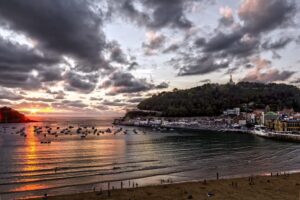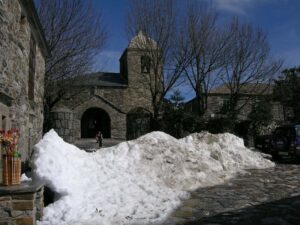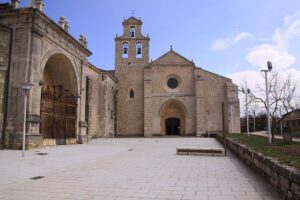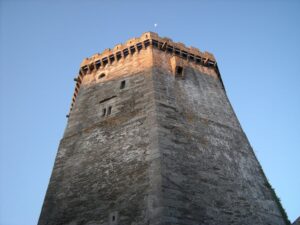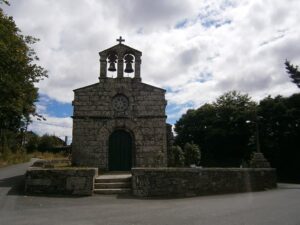
Every day on the Camino de Santiago is an adventure that blends physical effort, introspection, and unforgettable encounters. But there is one moment in particular that many pilgrims agree is magical: the sunset. That warm light that caresses the fields, cliffs, and villages of northern Spain not only paints postcard-like landscapes, but also invites you to stop, breathe, and contemplate.
Because the experience is lived with all five senses. And in this total experience, watching the sun set on the route becomes a silent, intimate, and powerful ritual. It’s the way the landscape thanks you for the day’s effort, embracing you with golden light and reminding you that you are in one of the most special places in the world.
Next, we show you where the best sunsets on the Camino de Santiago can be experienced, organised by route, so that you not only remember the destination but every step of the journey. And if you’re thinking about starting your route, there are plenty of companies to walk the Camino de Santiago that can help you organise everything. This way, you only need to worry about walking… and looking up at the sky when the evening falls.
Índice de contenidos
Camino Routes and Their Best Sunsets
Each route has its essence, its landscape, and of course, its sunsets. We take you through the most spectacular spots of each one so you know where it’s worth stopping to be amazed.
French Way
The most iconic and busiest route does not disappoint in terms of natural settings. It crosses mountains, valleys, and plains, offering sunsets worthy of a painting.
Roncesvalles (Navarre)
A starting point for many pilgrims, Roncesvalles is not only impressive for its historical importance but also for its natural surroundings. Nestled in the heart of the Navarre Pyrenees, surrounded by beech forests and mountains, it’s a place where the sunset arrives like a whisper among the trees.
The golden light filters through the leaves, painting the stone rooftops and the collegiate church in fiery hues, while the silence of the forest deepens with the fall of the evening. It’s a solemn, almost mystical scene that marks the start of the Camino with a clear message: you’re entering a journey that will transform your days… and your nights.
Alto del Perdón (Navarre)
On the outskirts of Pamplona, this pass has become famous for its metal sculptures of pilgrims that seem to walk towards the horizon. But what really takes your breath away is the panoramic view: rolling fields as far as the eye can see, which turn golden as the sun sets.
An ideal moment to sit in silence and gather mental energy for the stages ahead. The vastness of the landscape invites you to take a deep breath and stay a few more minutes, even if your body is asking for rest.
O Cebreiro (Lugo)
This small Celtic-origin village, perched in the Galician mountains, seems frozen in time. Its stone and straw pallozas blend with an almost magical mist that, at sunset, turns reddish and violet. Here, the sun slowly says goodbye, as if it knows you’re in a special place.
The views from the preromanesque church of Santa María are a spectacle that connects you with centuries of history and the most intimate present of the pilgrim.
The Northern Way
This route follows the Cantabrian coastline, and that means one thing: sunsets by the sea. The beauty here is wild, rugged, and profoundly moving.
La Concha Beach (San Sebastián)
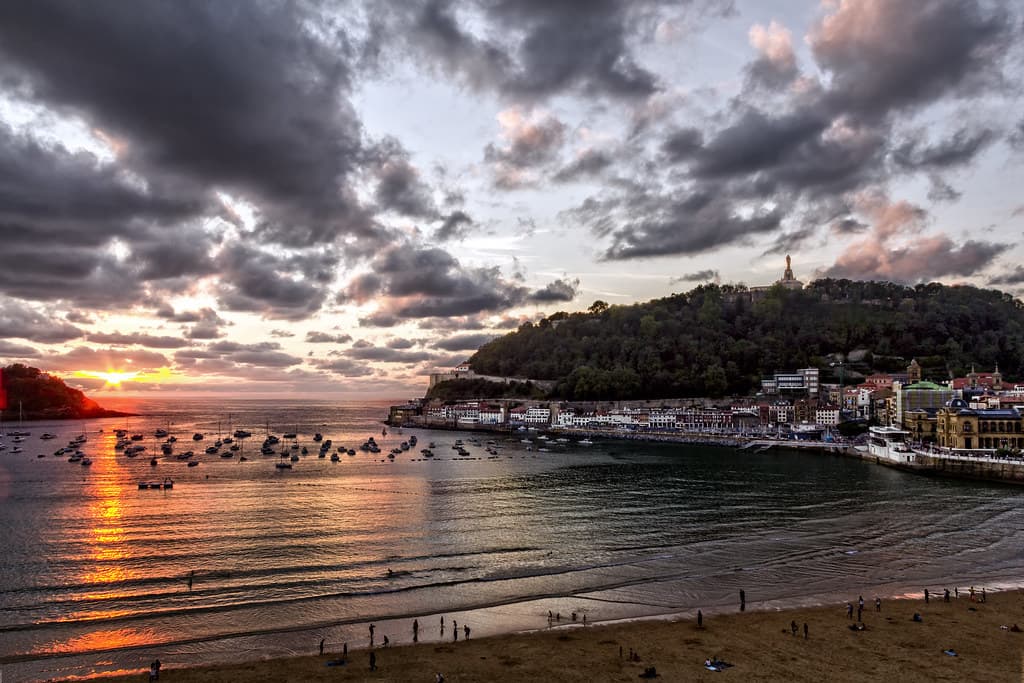
Although it’s at the beginning of the journey, if you can reach La Concha Beach at the end of the day, you’ll understand why many consider it one of the most beautiful sunsets in Europe. The sun hides behind Mount Igueldo, and the waves reflect the last light of the day as if they were liquid mirrors.
Walking along the shore or simply sitting on the sand can become one of the first great postcards of the experience.
Coast between Santander and Gijón
The coastal stretch between these two cities is a constant parade of cliffs, hidden beaches, and natural viewpoints. Each stage seems designed to end with a different sunset: orange on clear days, silver when the sea mist covers everything.
If you’re planning to travel through this area, take a look at the Santiago Way Santander Gijón, a perfect option for those seeking the sea and nature with every step.
Portuguese Way by the Coast
This itinerary gains followers every year due to its proximity to the Atlantic and its rich landscapes. Its sunsets by the sea are among the most thrilling in the entire network of paths.
Cliffs of A Guarda
In Galicia, near the mouth of the River Miño, the small village of A Guarda is set on hills that dive into the ocean. From there, the sunset is experienced at height, with the sound of the waves and the changing colours of the sky that seem to set the sea on fire. The sense of vastness is overwhelming: no buildings, no noise. Just the sea, the sky, and the silence of the end of the day.
A lovely way to start the pilgrimage for those opting to do the way from A Guarda to Santiago.
Miño River Mouth
The natural border between Portugal and Galicia offers a postcard view at dusk. The river meets the sea while seagulls and cormorants return to their nests. This stretch can be considered the grand finale to the Santiago Way Porto to A Guarda.
Primitive Way
The oldest route is also one of the most mountainous. The landscapes of Asturias and Galicia offer intense panoramas that reach the next level at the end of the day.
Route of the Hospitals
One of the most demanding stages of the Primitive Way takes place along ancient paths on the ridge. Here, where the wind is constant and the silence almost total, the sunsets are intimate and overwhelming. From above, valleys gradually sink into shadow, while the last rays tint the mountains copper.
Monte Naranco (Oviedo)
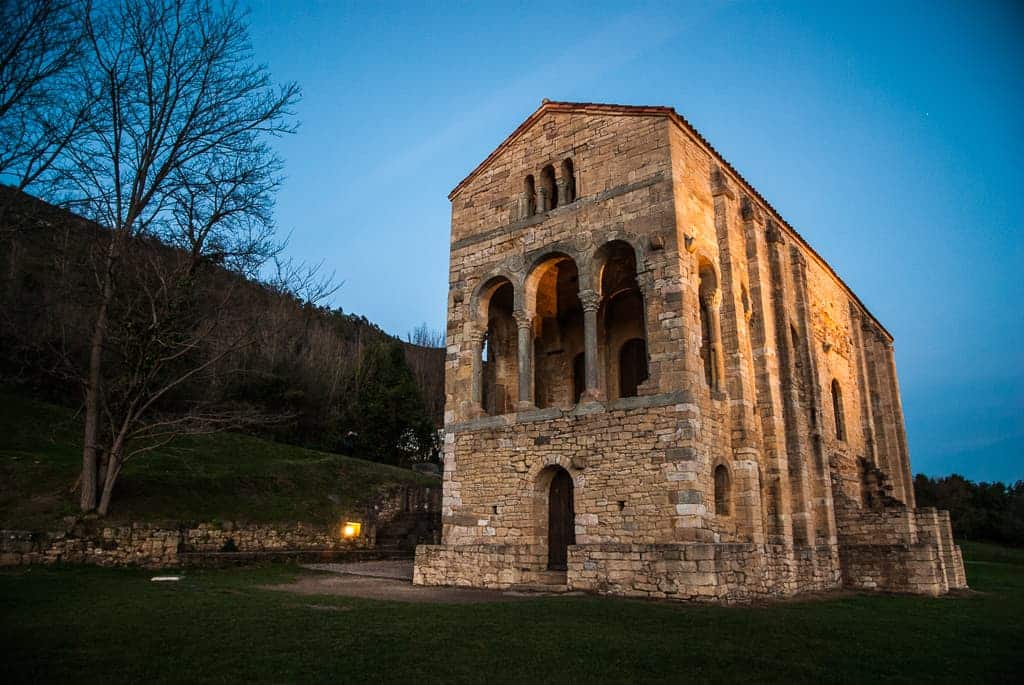
Before starting the Camino or as a final stop if you only do one section, Monte Naranco offers spectacular views over the city of Oviedo and the Picos de Europa in the distance. An ideal place to recharge your energy or say goodbye to the Camino with one last sunset, with the silhouette of the Santa María del Naranco church outlined against the sky.
English Way
Although shorter, this route hides landscape surprises, ideal for those who love tranquillity and less crowded paths.
Ría de Ferrol
The calm waters of the estuary reflect the colours of the sky like a mirror. If you finish your stage in Neda or Fene, you’ll have one of the most serene sunsets in all of Galicia. The fishing boats, the suspended mist, and the call of seabirds bring a peace that’s hard to find elsewhere.
Alto de Bruma
This point, which often marks the end of the stage for many pilgrims, is surrounded by wooded hills and meadows. As the sun sets, the mist begins to descend slowly, creating a mystical and cosy atmosphere. There’s no better place to regain strength under the soft light of dusk.
Way to Finisterre and Muxía
This extension of the Camino beyond Santiago literally takes you to the “end of the world”. The sunsets here are simply unforgettable.
Finisterre Lighthouse
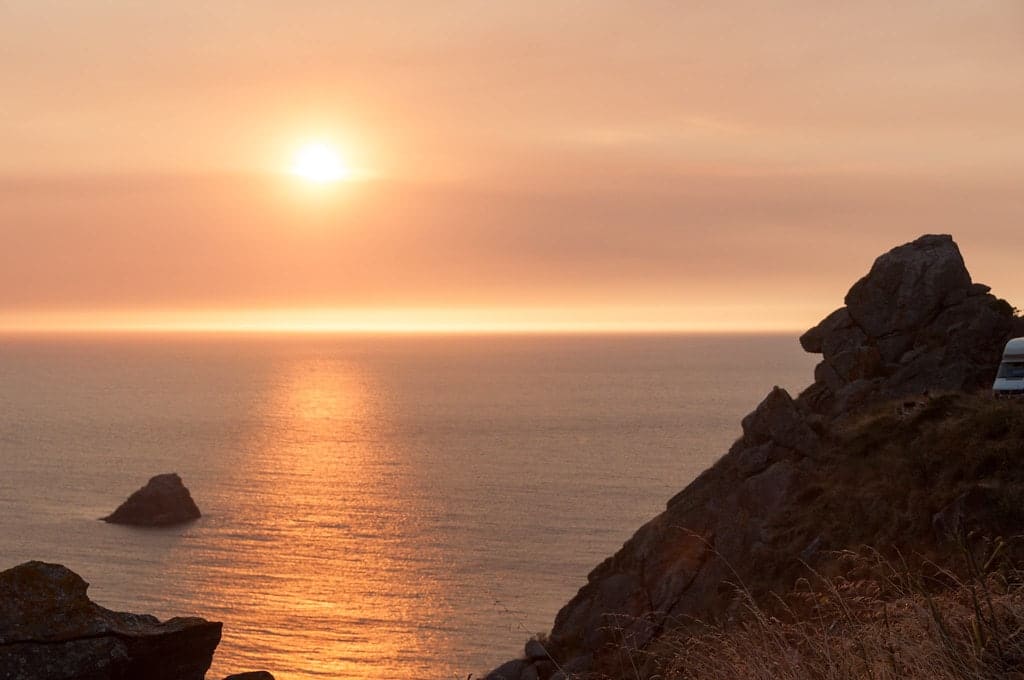
There are no words to describe what it feels like to watch the sun set at the westernmost point of continental Europe. The lighthouse, the cliffs, the wind, and the sound of the Atlantic make this moment forever etched in memory. Many pilgrims symbolically burn their boots here, marking the end of a vital stage.
Santuario da Barca (Muxía)

This rocky spot by the sea is a place of legend. As evening falls, the waves crash against the rocks, while the sky changes from blue to orange, to red, and then to violet. This is where the Camino ends for many, and it’s easy to understand why.
What makes the sunsets on the Camino so special?
It’s not just the landscape. On the Camino, every sunset has a symbolic value. It marks the end of a stage, the overcoming of a challenge, the well-earned rest.
The light in Galicia, Asturias, or Castilla y León has a unique quality: soft, golden, nostalgic. Crossing wheat fields on the plateau, walking by cliffs, or through damp forests becomes even more special with that last light that transforms everything.
Then there’s the emotional state of the pilgrim. Tired, yes, but full of gratitude. Every sunset becomes a small ritual, an opportunity to reflect, give thanks, and simply be present. It’s the moment when many write in their journal, chat with new friends… or simply sit in silence.
Tips for enjoying the best sunsets on the Camino
- Plan your stages so that the end of the day finds you in an open place with a good view. It’s not always necessary to push forward. Sometimes, the best part of the Camino is staying still.
- Check the sunset time every day. It changes slightly and will help you plan to arrive on time.
- Include a small flashlight or headlamp if you plan to stay until the end of dusk away from the hostel.
- Ideal places to sleep with sunsets: coastal areas, rural viewpoints, mountain tops, or villages with panoramic views.
- Disconnect from your phone for a while. Take photos, yes, but then put it away. The most powerful memory isn’t in the gallery: it’s in your mind.
- Bring something light to sit on if the location allows: a cloth, a folded jacket… and simply observe.
- Talk less and feel more. If you’re with others, try experiencing at least one sunset in silence. You’ll see how everything changes.
The Camino de Santiago is an experience written slowly over time. The landscapes, the people, the silences… and also the light. The sunsets are daily gifts, moments to stop and feel that you are exactly where you need to be.
It doesn’t matter which route you choose. In each one, the sun will set differently. The important thing is that you are there to witness it. Because the true journey is not measured in kilometres, but in moments that stay with you forever.

